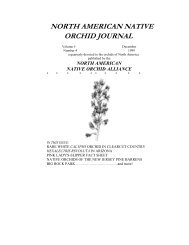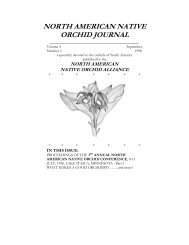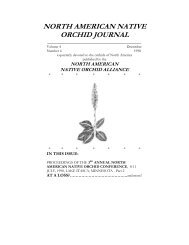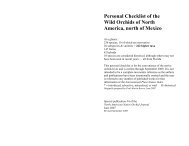north american native orchid journal - at The Culture Sheet
north american native orchid journal - at The Culture Sheet
north american native orchid journal - at The Culture Sheet
You also want an ePaper? Increase the reach of your titles
YUMPU automatically turns print PDFs into web optimized ePapers that Google loves.
Brown & Folsom: WILD ORCHIDS OF THE WHITE MOUNTAINS OF NEW HAMPSHIRE AND MAINE<br />
Spiranthes cernua (Linnaeus) L.C. Richard<br />
nodding ladies’-tresses<br />
Range: South Dakota east to Nova Scotia, south to Texas and<br />
Florida<br />
In the White Mountains region: locally common<br />
Plant: terrestrial, 10-50 cm tall<br />
Leaves: 3-5; appearing basal or on the lower portion of the<br />
stem; linear-oblanceol<strong>at</strong>e, up to 2 cm wide × 26 cm long;<br />
ascending to spreading; leaves are usually present <strong>at</strong> anthesis<br />
in most races<br />
Flowers: 10-50; in a spike, tightly to loosely spiraled with 5<br />
or more flowers per cycle, nodding from the base of the<br />
perianth or rarely ascending; bracts with a white or light<br />
green central stripe; sepals and petals similar, lanceol<strong>at</strong>e;<br />
perianth white, ivory; lip oblong, broad <strong>at</strong> the apex, the<br />
central portion of the lip, in some races, creamy-yellow or<br />
green; the sepals approxim<strong>at</strong>e and extending forward<br />
sometimes arching above the flower; individual flower size<br />
0.6-10.5 mm<br />
Habit<strong>at</strong>: wet to dryish open sites, lightly wooded areas, moist<br />
grassy roadsides, etc.<br />
Flowering period: l<strong>at</strong>e August to October<br />
Of all of our <strong>n<strong>at</strong>ive</strong> <strong>orchid</strong>s in North America, Spiranthes<br />
cernua is the most difficult for which to give a simple, concise<br />
description and narr<strong>at</strong>ive. Because it is a compilospecies–one<br />
th<strong>at</strong> has gene flow from several different similar species–<br />
plants in different geographic areas have strong resemblances<br />
to the basic diploid species contributing th<strong>at</strong> unidirectional<br />
gene flow. In <strong>north</strong>eastern North America we are somewh<strong>at</strong><br />
fortun<strong>at</strong>e th<strong>at</strong> the only basic diploid Spiranthes th<strong>at</strong> contributes gene flow <strong>at</strong> this time is S.<br />
ochroleuca. <strong>The</strong> so called ―Quebec race‖ shows possible gene flow from S. casei, but th<strong>at</strong><br />
remains to be proven. Th<strong>at</strong> is not to say th<strong>at</strong> identific<strong>at</strong>ion of S. cernua plants is always easy—<br />
quite to the contrary. Because the plants are apomictic—not fertilized in the traditional sexual<br />
manner, but producing seed (actually minute plantlets) directly without fertiliz<strong>at</strong>ion–local<br />
races occur th<strong>at</strong> are quite distinctive.<br />
255













